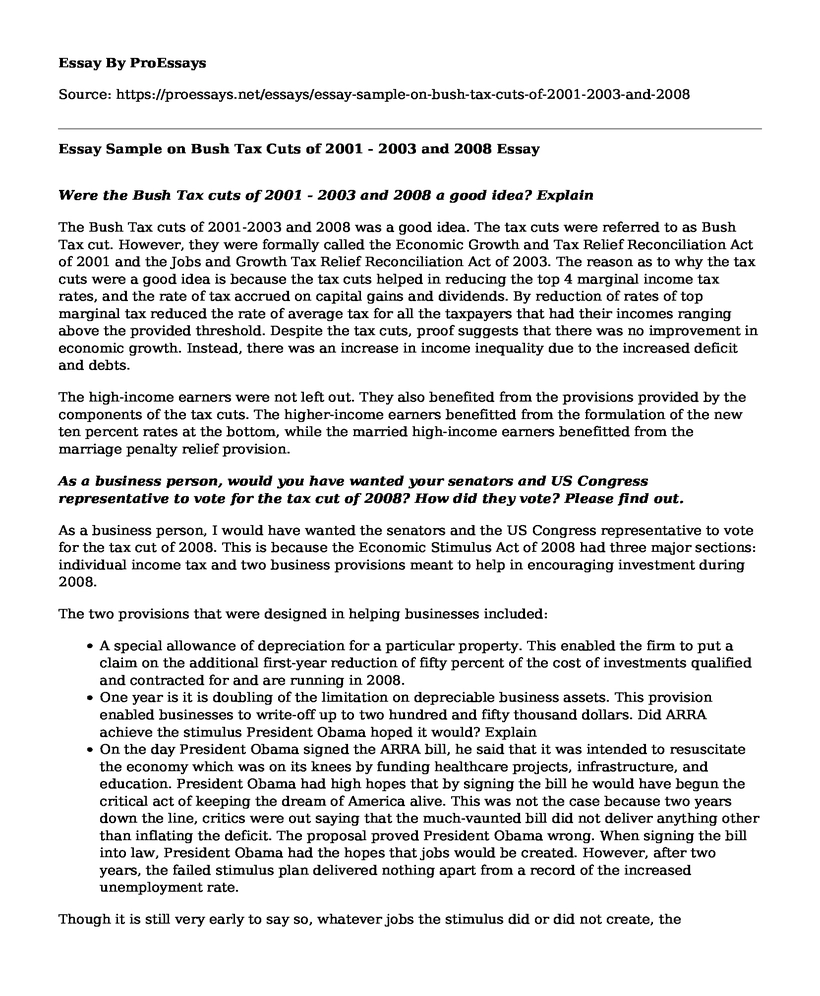The Bush Tax cuts of 2001-2003 and 2008 was a good idea. The tax cuts were referred to as Bush Tax cut. However, they were formally called the Economic Growth and Tax Relief Reconciliation Act of 2001 and the Jobs and Growth Tax Relief Reconciliation Act of 2003. The reason as to why the tax cuts were a good idea is because the tax cuts helped in reducing the top 4 marginal income tax rates, and the rate of tax accrued on capital gains and dividends. By reduction of rates of top marginal tax reduced the rate of average tax for all the taxpayers that had their incomes ranging above the provided threshold. Despite the tax cuts, proof suggests that there was no improvement in economic growth. Instead, there was an increase in income inequality due to the increased deficit and debts.
The high-income earners were not left out. They also benefited from the provisions provided by the components of the tax cuts. The higher-income earners benefitted from the formulation of the new ten percent rates at the bottom, while the married high-income earners benefitted from the marriage penalty relief provision.
As a business person, would you have wanted your senators and US Congress representative to vote for the tax cut of 2008? How did they vote? Please find out.
As a business person, I would have wanted the senators and the US Congress representative to vote for the tax cut of 2008. This is because the Economic Stimulus Act of 2008 had three major sections: individual income tax and two business provisions meant to help in encouraging investment during 2008.
The two provisions that were designed in helping businesses included:
- A special allowance of depreciation for a particular property. This enabled the firm to put a claim on the additional first-year reduction of fifty percent of the cost of investments qualified and contracted for and are running in 2008.
- One year is it is doubling of the limitation on depreciable business assets. This provision enabled businesses to write-off up to two hundred and fifty thousand dollars. Did ARRA achieve the stimulus President Obama hoped it would? Explain
- On the day President Obama signed the ARRA bill, he said that it was intended to resuscitate the economy which was on its knees by funding healthcare projects, infrastructure, and education. President Obama had high hopes that by signing the bill he would have begun the critical act of keeping the dream of America alive. This was not the case because two years down the line, critics were out saying that the much-vaunted bill did not deliver anything other than inflating the deficit. The proposal proved President Obama wrong. When signing the bill into law, President Obama had the hopes that jobs would be created. However, after two years, the failed stimulus plan delivered nothing apart from a record of the increased unemployment rate.
Though it is still very early to say so, whatever jobs the stimulus did or did not create, the unemployment rate never came down. However, it is said that the unemployment rate is still high even after kick-starting the stimulus because much of the budget is yet to be spent. Out of the $787 billion of the original budget, only $275 billion has been spent towards the actual government spending. As per the stimulus plan, the rest of the budget would be distributed through 2016, a time which the success of the plan could be judged.
It is sad to say the stimulus has turned out to be one of the big promises with huge spending but rather very little results. Barely five years after the billed was signed into law and spending hundreds of billions of dollars, but still millions of people still asking for the jobs created by the bill as it was promised. The stimulus could have performed better had it been well constructed. But simply put, the stimulus prevented a recession which could have turned out to depression. Further, the stimulus created averagely 1.7 million jobs every year for four years. This raised the output of the economy by 2% to 3% from 2009 to 2011. The stimulus also prevented the increase in poverty. It is a fact that without the stimulus plan, about 5.4 million additional people would have remained poor in the year 2010.
Works Cited
Ballard-Rosa, Cameron, Lucy Martin, and Kenneth Scheve. "The structure of American income tax policy preferences." The Journal of Politics 79.1 (2017): 1-16.
Burman, Leonard E., et al. "Economic and Distributional Effects of Tax Expenditure Limits." The Economics of Tax Policy (2017): 109-44.
Feldstein, Martin. "The Shape of US Tax Reform." Project Syndicate.(January 30). Available at: https://www. project-syndicate. org/commentary/congress-republican-tax-reform-by-martin-feldstein-2017-01. 2017.
Horton, Emily. "The Legacy of the 2001 and 2003 'Bush'Tax Cuts." Washington: Center on Budget and Policy Priorities(2017).
Cite this page
Essay Sample on Bush Tax Cuts of 2001 - 2003 and 2008. (2022, Dec 20). Retrieved from https://proessays.net/essays/essay-sample-on-bush-tax-cuts-of-2001-2003-and-2008
If you are the original author of this essay and no longer wish to have it published on the ProEssays website, please click below to request its removal:
- Business Paper Sample - Cost Estimating in the Acquisition Field
- The African Development Bank (AFDB) Overview Paper Example
- Paper Example on Banking Supervision
- Tax Cut Essay Example
- Paper Example on Advertising & Marketing Agency: Concentrating on Increasing Market Share
- Essay Sample on 2020 Rhodes Budget: Investing in Education & Basic Services
- Essay Example on Creating Financial Stability: A Short-Term Action Plan







